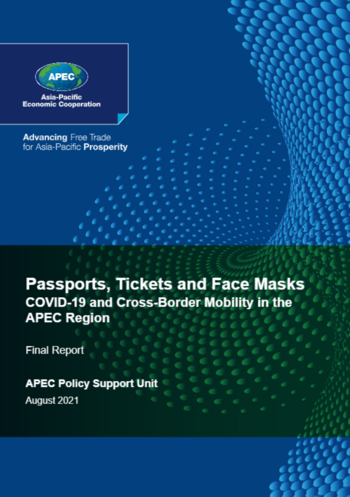Building Economic Resiliency in the APEC Region Post-COVID-19
Building Economic Resiliency in the APEC Region Post-COVID-19
Working with the Asia-Pacific Economic Cooperation, Soomin Jun (Master’s in International Policy '22) found new connections between her interests in supporting the economic development of marginalized groups with policies like climate change.

The Asia-Pacific Economic Cooperation (APEC) is a regional economic forum with 21 member economies, including the US, China, and Russia, headquartered in Singapore. As a summer graduate intern at APEC, I worked closely with APEC’s policy unit that oversees and conducts policy research and analysis for publications and reports, which are used as key discussion agendas in ministerial level discussions and conferences. The Policy Support Unit (PSU)’s core areas of work are 1) trade and investment liberalization and facilitation, 2) structural reform, 3) connectivity including supply chain connectivity and global supply chains, 4) economic and financial analysis, and 5) sustainable economic development. During my summer internship, I was able to gain direct experience with almost all of these core areas through conducting quantitative and qualitative research.

The PSU has been working on a publication that analyzed the impacts of travel restrictions during the pandemic. The report provided evidence and policy recommendations for APEC economies to resume cross-border travel in a safe and equitable way. I was tasked to draft two sections of the report, including a literature review of various multilateral organizations’ initiatives on safe re-opening, and an analysis of the disproportionate impacts of travel restrictions on vulnerable population, especially women. Women were not only experiencing economic impacts from border closures, such as loss of jobs and business closures, but women seeking abortion procedures in countries with restrictive regulations faced significant challenges when cross-border travel was limited to “essential workers.” Such challenges were even more pronounced for lower-income women or women with disabilities who may not be able to access services through other means domestically.
I also worked on drafting APEC’s flagship publication, APEC in Charts 2021, which resides within APEC’s fourth core area of work, economic and financial analysis. APEC in Charts is an annual publication that provides a visual overview of the region’s economic, trade and investment performance. Using data from international organizations like the World Bank, International Monetary Fund, and the United Nations, I calculated aggregate statistics for the APEC region on the following indicators: trend in trade, tariff liberalization indicators such as free trade agreements, trend in FDI inflows and outflows, COVID-19 vaccination status, and various sustainability indicators such as household food waste and greenhouse gas emissions trends.
Since APEC includes Taiwan and Hong Kong, both of which did not have disaggregated data, the most challenging part of this task was to locate and calculate the information using limited data. While data disaggregation was challenging, I was thankful for all those nights that I stayed up in the first quarter to complete data aggregation for economic analysis assignments for the Global Economy course, INTLPOL 302, which built a foundation for key skills required at APEC.

I also immersed myself in the topic of climate change over the summer. Policy actions on climate change became one of the center of APEC’s agendas to build economic resilience post-COVID. I drafted a section on climate change in APEC’s Regional Trends Analysis (ARTA) report by conducting quantitative and qualitative research on green indicators. Calculating carbon emissions was one challenge, but comparing how much each economy had pledged to reduce emissions and what it would actually take to keep global warming below 2°C was another challenge.
Climate change was not a topic I was very familiar with from a research standpoint, but I took the opportunity to self-educate through reading various literature, including the most recent publication from the Intergovernmental Panel on Climate Change (IPCC). It was striking that more than 60% of global greenhouse gases were generated by APEC economies. Unless APEC as a region curbs cumulative emissions, the expected repercussions are disastrous. Again, the most vulnerable – including women and girls, migrants, those in poverty, mountain communities and people in urban slums – will experience more severe consequences, and the repercussions are even more pronounced for those in developing nations.
This 11-week internship experience at APEC over the summer was a rewarding one that helped me understand the way multilateral organizations work. I was motivated by working with an organization responsible for shaping economic policies through cooperation to build resilience in the post-COVID world. Plus, I was able to tone up key techniques learned from MIP’s core courses such as STATA and advanced excel skills. Although it was a remote internship, I benefited from learning from my fellow interns and co-researchers on their broad range of expertise and experience. I strongly recommend future MIP students work with APEC over the summer as policy interns!

